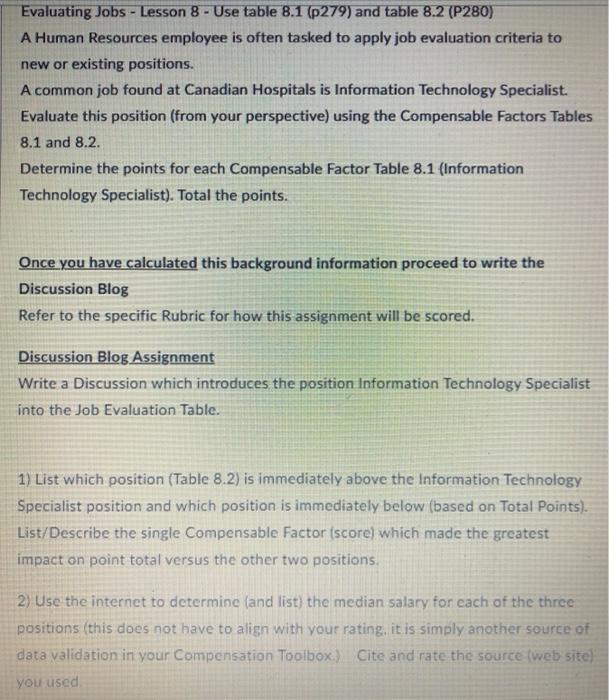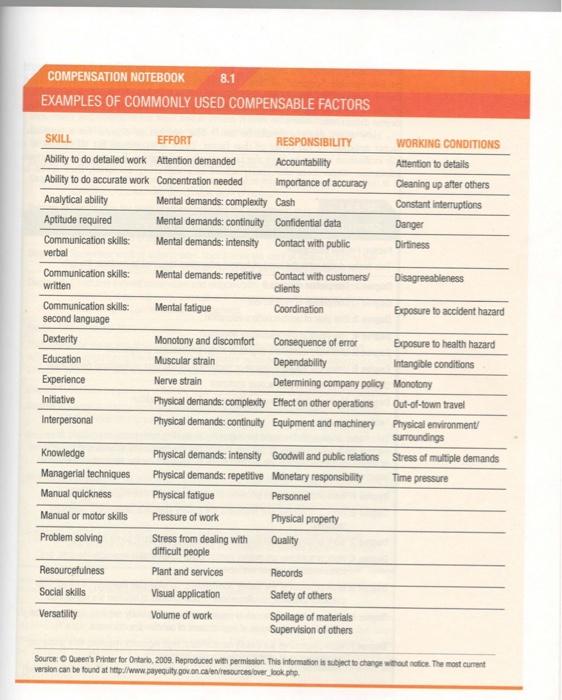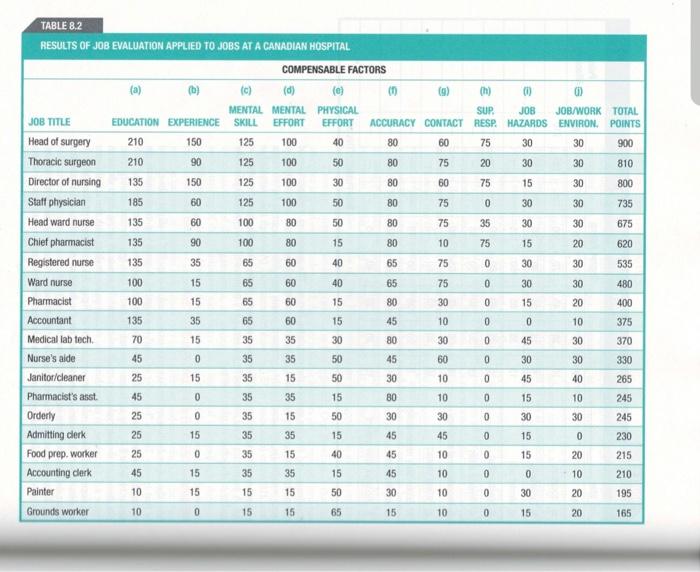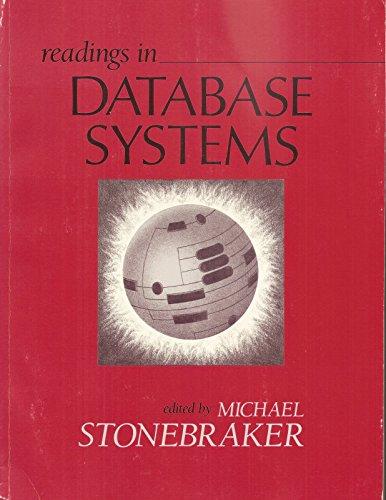Answered step by step
Verified Expert Solution
Question
1 Approved Answer
please answer 1,2and 3 Evaluating Jobs - Lesson 8 - Use table 8.1 (p279) and table 8.2 (P280) A Human Resources employee is often tasked





please answer 1,2and 3
Evaluating Jobs - Lesson 8 - Use table 8.1 (p279) and table 8.2 (P280) A Human Resources employee is often tasked to apply job evaluation criteria to new or existing positions. A common job found at Canadian Hospitals is Information Technology Specialist. Evaluate this position (from your perspective) using the Compensable Factors Tables 8.1 and 8.2. Determine the points for each Compensable Factor Table 8.1 (Information Technology Specialist). Total the points. Once you have calculated this background information proceed to write the Discussion Blog Refer to the specific Rubric for how this assignment will be scored. Discussion Blog Assignment Write a Discussion which introduces the position Information Technology Specialist into the Job Evaluation Table. 1) List which position (Table 8.2) is immediately above the Information Technology Specialist position and which position is immediately below (based on Total Points). List/Describe the single Compensable Factor (score) which made the greatest impact on point total versus the other two positions, 2) Use the internet to determine (and list) the median salary for each of the three positions (this does not have to align with your rating, it is simply another source of data validation in your compensation Toolbox.) Cite and rate the source (web site) you used 3) Reply to another discussion thread either agreeing or disagreeing with the rating, and state why you agree or disagree. COMPENSATION NOTEBOOK 8.1 EXAMPLES OF COMMONLY USED COMPENSABLE FACTORS SKILL EFFORT RESPONSIBILITY WORKING CONDITIONS Ability to do detailed work Attention demanded Accountability Attention to details Ability to do accurate work. Concentration needed Importance of accuracy Cleaning up after others Analytical ability Mental demands: complexity Cash Constant interruptions Aptitude required Mental demands: continuity Confidential data Danger Communication skills: Mental demands: intensity Contact with public Dirtiness verbal Communication skills: Mental demands: repetitive Contact with customers Disagreeableness written clients Communication skills: Mental fatigue Coordination Exposure to accident hazard second language Dexterity Monotony and discomfort Consequence of error Exposure to health hazard Education Muscular strain Dependability Intangible conditions Experience Nerve strain Determining company policy Monotony Initiative Physical demands: complexity Etect on other operations Out-of-town travel Interpersonal Physical demands: continuity Equipment and machinery Physical environment surroundings Knowledge Physical demands: intensity Goodwill and public relations Stress of multiple demands Managerial techniques Physical demands: repetitive Monetary responsibility Time pressure Manual quickness Physical fatigue Personnel Manual or motor skills Pressure of work Physical property Problem solving Stress from dealing with Quality difficult people Resourcefulness Plant and services Records Social skills Visual application Safety of others Versatility Volume of work Spoilage of materials Supervision of others Source Queen's Printer for Ontario, 2009. Reproduced with permission. This information is subject to change without notice. The most current version can be found at http://www.payequity gow.on.ca/resources overlook pho FIGURE 8.1 SAMPLE SUMMARY RATING CHART FOR POINT METHOD OF JOB EVALUATION Job title: Degree Rating Factor 1 2 3 5 6 a) Education 10 25 45 70 100 135 Points Allocated 7 185 210 b) Experience 0 15 35 50 90 120 150 15 35 65 100 125 15 35 60 80 100 15 30 40 50 65 15 - IIIIIIIII 30 45 65 C) Mental skill d Mental effort e) Physical effort 1) Importance of accuracy 9) Patient contact h) Supervisory responsibility Job hazards D Job/work environment 80 IIIIIIII 10 30 45 60 75 0 20 35 50 75 0 15 30 45 65 10 20 30 40 55 Total Points for This Job experience, and five for each of the remaining factors. The maximum total number of points that a job can receive is 1,000, and the minimum a job can receive is 90 points. The factor weights (as indicated by the maximum points available for a given factor) range from 210 points (education) to 55 Gob/work environment). (Although this example has a round number of points (1,000) as its maximum, there is no inherent advantage to this. A maximum could just as casily be, say, 1,140 points, and that wouldn't affect the quality of the job evaluation system.) APPLYING THE JOB EVALUATION SYSTEM After the job evaluation system has been established, it is applied to all the jobs covered by that system. Then a "hierarchy of jobs" is generated. A good way to summarize the results of the job evaluation, and the resulting hierarchy of jobs, is by developing a table similar to Table 8.2. This table incorporates the results for a hypothetical set of hospital jobs, based on the job evaluation results taken from the summary rating charts shown in Figure 8.1. Of course, in rating these jobs, evaluators are working with the actual factor and degree definitions, which are not shown in Figure 8.1, and applying them to cach job description. However, as an example, for the factor of education, the factor and degree definitions shown in Table 8.1 were used. What does the hierarchy of jobs in Table 8.2 tell us? Fint, among this sample of hos pital jobs (normally all hospital jobs would be included rather than just some of them) the most valuable job to the organization is head of surgery, while the least valuable job LOL CHAPTER 8 Evaluating Jobs The Port Metodo oo Emin TABLE 8.2 RESULTS OF JOB EVALUATION APPLIED TO JOBS AT A CANADIAN HOSPITAL COMPENSABLE FACTORS (b) (d) th) 6) MENTAL MENTAL PHYSICAL SUP JOB JOB/WORK TOTAL JOB TITLE EDUCATION EXPERIENCE SKILL EFFORT EFFORT ACCURACY CONTACT RESP. HAZARDS ENVIRON. POINTS Head of surgery 210 150 125 100 40 80 60 75 30 30 900 Thoracic surgeon 210 90 125 100 50 80 75 20 30 30 810 Director of nursing 135 150 125 100 30 60 75 15 30 800 Staff physician 185 60 125 100 50 75 0 30 30 735 Head Ward nurse 135 60 100 80 50 80 75 35 30 30 675 Chief pharmacist 135 90 100 80 15 80 10 75 15 20 620 Registered nurse 135 35 65 60 40 65 75 0 30 30 535 Ward nurse 100 15 65 60 40 65 75 0 30 30 480 Pharmacist 100 15 65 60 15 80 30 0 15 20 400 Accountant 135 35 65 60 15 45 10 0 0 10 375 Medical lab tech 70 15 35 35 30 80 30 0 45 30 370 Nurse's aide 45 0 35 35 50 45 60 0 30 30 330 Janitor/cleaner 25 15 35 15 50 30 10 0 45 40 265 Pharmacist's asst 45 0 35 35 15 80 10 0 15 10 245 Orderly 25 0 35 15 50 30 30 0 30 30 245 Admitting clerk 25 15 35 35 15 45 45 0 15 0 230 Food prep worker 25 0 35 15 40 45 10 0 15 20 215 Accounting clerk 45 15 35 35 15 45 10 0 0 10 210 Painter 10 15 15 15 50 30 10 0 30 20 195 Grounds worker 10 0 15 15 65 15 10 0 15 20 165 Step by Step Solution
There are 3 Steps involved in it
Step: 1

Get Instant Access to Expert-Tailored Solutions
See step-by-step solutions with expert insights and AI powered tools for academic success
Step: 2

Step: 3

Ace Your Homework with AI
Get the answers you need in no time with our AI-driven, step-by-step assistance
Get Started


